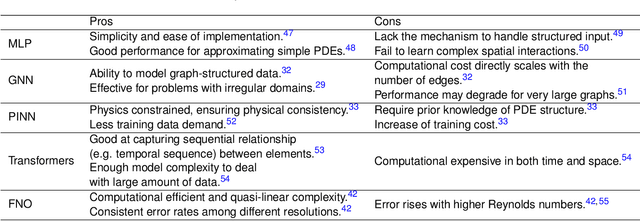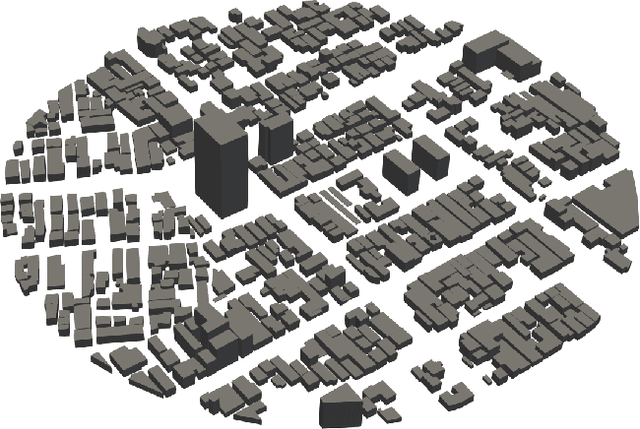Wenhui Peng
Leon
Modeling Multivariable High-resolution 3D Urban Microclimate Using Localized Fourier Neural Operator
Nov 18, 2024Abstract:Accurate urban microclimate analysis with wind velocity and temperature is vital for energy-efficient urban planning, supporting carbon reduction, enhancing public health and comfort, and advancing the low-altitude economy. However, traditional computational fluid dynamics (CFD) simulations that couple velocity and temperature are computationally expensive. Recent machine learning advancements offer promising alternatives for accelerating urban microclimate simulations. The Fourier neural operator (FNO) has shown efficiency and accuracy in predicting single-variable velocity magnitudes in urban wind fields. Yet, for multivariable high-resolution 3D urban microclimate prediction, FNO faces three key limitations: blurry output quality, high GPU memory demand, and substantial data requirements. To address these issues, we propose a novel localized Fourier neural operator (Local-FNO) model that employs local training, geometry encoding, and patch overlapping. Local-FNO provides accurate predictions for rapidly changing turbulence in urban microclimate over 60 seconds, four times the average turbulence integral time scale, with an average error of 0.35 m/s in velocity and 0.30 {\deg}C in temperature. It also accurately captures turbulent heat flux represented by the velocity-temperature correlation. In a 2 km by 2 km domain, Local-FNO resolves turbulence patterns down to a 10 m resolution. It provides high-resolution predictions with 150 million feature dimensions on a single 32 GB GPU at nearly 50 times the speed of a CFD solver. Compared to FNO, Local-FNO achieves a 23.9% reduction in prediction error and a 47.3% improvement in turbulent fluctuation correlation.
Toward a Better Understanding of Fourier Neural Operators: Analysis and Improvement from a Spectral Perspective
Apr 10, 2024Abstract:In solving partial differential equations (PDEs), Fourier Neural Operators (FNOs) have exhibited notable effectiveness compared to Convolutional Neural Networks (CNNs). This paper presents clear empirical evidence through spectral analysis to elucidate the superiority of FNO over CNNs: FNO is significantly more capable of learning low-frequencies. This empirical evidence also unveils FNO's distinct low-frequency bias, which limits FNO's effectiveness in learning high-frequency information from PDE data. To tackle this challenge, we introduce SpecBoost, an ensemble learning framework that employs multiple FNOs to better capture high-frequency information. Specifically, a secondary FNO is utilized to learn the overlooked high-frequency information from the prediction residual of the initial FNO. Experiments demonstrate that SpecBoost noticeably enhances FNO's prediction accuracy on diverse PDE applications, achieving an up to 71% improvement.
Fourier neural operator for real-time simulation of 3D dynamic urban microclimate
Aug 08, 2023



Abstract:Global urbanization has underscored the significance of urban microclimates for human comfort, health, and building/urban energy efficiency. They profoundly influence building design and urban planning as major environmental impacts. Understanding local microclimates is essential for cities to prepare for climate change and effectively implement resilience measures. However, analyzing urban microclimates requires considering a complex array of outdoor parameters within computational domains at the city scale over a longer period than indoors. As a result, numerical methods like Computational Fluid Dynamics (CFD) become computationally expensive when evaluating the impact of urban microclimates. The rise of deep learning techniques has opened new opportunities for accelerating the modeling of complex non-linear interactions and system dynamics. Recently, the Fourier Neural Operator (FNO) has been shown to be very promising in accelerating solving the Partial Differential Equations (PDEs) and modeling fluid dynamic systems. In this work, we apply the FNO network for real-time three-dimensional (3D) urban wind field simulation. The training and testing data are generated from CFD simulation of the urban area, based on the semi-Lagrangian approach and fractional stepping method to simulate urban microclimate features for modeling large-scale urban problems. Numerical experiments show that the FNO model can accurately reconstruct the instantaneous spatial velocity field. We further evaluate the trained FNO model on unseen data with different wind directions, and the results show that the FNO model can generalize well on different wind directions. More importantly, the FNO approach can make predictions within milliseconds on the graphics processing unit, making real-time simulation of 3D dynamic urban microclimate possible.
 Add to Chrome
Add to Chrome Add to Firefox
Add to Firefox Add to Edge
Add to Edge